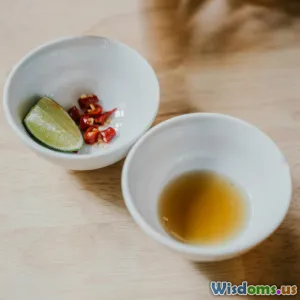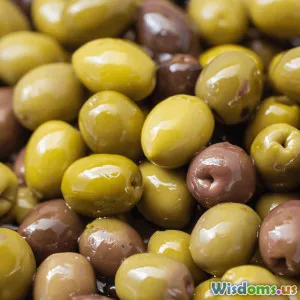
Mastering Flavor Combinations in Cooking
8 min read Unlock the art of flavor combinations to elevate your cooking with proven techniques and expert insights. (0 Reviews)
Mastering Flavor Combinations in Cooking
Cooking is an art, but more than that, it's a science steeped in creativity and experimentation. One of the pivotal skills that separates a good cook from a truly great one is the ability to master flavor combinations. Whether you're a home cook or an aspiring professional chef, understanding how to pair ingredients and balance flavors can elevate your dishes from ordinary to extraordinary.
Introduction: Why Flavor Combinations Matter
Imagine biting into a dish that instantly delights your palate—a harmonious dance of sweet, salty, sour, bitter, and umami that keeps you coming back for more. That magic happens when flavors are thoughtfully combined.
Good flavor pairing is not just about luck or intuition. It's rooted in understanding chemical profiles, cultural traditions, and the way your senses respond. Taste buds detect the basic tastes, but the brain interprets textures, aromas, and even memories associated with food. By mastering flavor combinations, you unlock new culinary dimensions and broaden your creative potential.
The Science Behind Flavor Pairing
The link between flavor combinations and chemistry was given prominence by food scientists who analyzed shared flavor compounds. For example, white chocolate and caviar surprisingly share aromatic compounds like trimethylamine, which make this odd pair work in a unique way.
Flavor Families and Key Elements
- Sweetness: Often from sugars or natural compounds. Balances bitterness and acidity.
- Saltiness: Enhances flavor, suppresses bitterness. Salt is the universal flavor amplifier.
- Sourness: From acids like citric or malic acid. Adds brightness and contrast.
- Bitterness: Found in coffee, kale, and some herbs. Adds depth.
- Umami: The savory, mouth-filling taste from glutamates found in mushrooms, aged cheeses, soy sauce.
Experts like chef Michael Rubinstein describe umami as the secret weapon to bring flavors together, enriching the overall palate experience.
Flavor Pairing Rules of Thumb
- Complementary Pairings: Combining ingredients with shared flavor compounds for harmonious taste—for instance, basil and tomato or apple and cinnamon.
- Contrasting Pairings: Balancing opposing tastes like salty and sweet (think salted caramel) or sour and fatty (lemon on fried fish).
- Texture and Temperature Considerations: Crisp and soft, hot and cold can enhance enjoyment even if the flavors stand alone.
Practical Strategies to Master Flavor Combinations
1. Start with Classic Combinations
Explore tried-and-true pairings well-loved in cuisine:
- Tomato and basil: The earthiness of tomato meets the minty, peppery notes of basil.
- Lemon and garlic: The acidity cuts through garlic’s pungency, common in Mediterranean cooking.
- Chocolate and chili: The heat enhances cocoa's depth.
Understanding why these work gives you a basis to test substitutions.
2. Use the Flavor Map
The flavor map is a tool that charts ingredients based on flavor profiles. Online resources like Foodpairing.com use chemical data to suggest unusual but compatible pairings based on shared aromatic molecules.
For example, coffee shares principal compounds with blue cheese and grapefruit, inspiring creative and daring combinations.
3. Learn from World Cuisines
Global cuisines have developed through natural ingredient availability and cultural evolution, producing signature pairing principles.
- Asian cuisine often balances sweet, salty, sour, and spicy — think Thai dishes combining tamarind, fish sauce, palm sugar, and chilis.
- French cuisine values the art of balancing butter creaminess with acidity from wine reductions.
Exploring these traditions expands your flavor horizon.
4. Experiment Mindfully
Cooking is experiential. Use small batches to test new combinations. Pair ingredients one at a time and taste often. Keep notes of successful pairings.
Use herbs, spices, and acids as modifiers. For example, adding a squeeze of lime to a grilled dish can brighten and unify complex components.
5. Balance Intensity
Some ingredients dominate while others subtlety influence. To avoid clashes, balance robust flavors with muted ones. For example, a spicy chili needs a cooling dairy or starchy base.
6. Use Contrasts to Add Interest
A dish with only one dominant flavor can be predictable. Introduce contrasting notes to play on the palate. Sweet countering salty or acid balancing fat adds complexity.
Example: A rich grilled salmon served with a pineapple salsa adds sweet and tart brightness.
Real World Insights: Chefs on Flavor Pairing
Renowned chef Ferran Adrià said, “Taste needs to surprise; it thrives on the unexpected.” The experimental culinary movement, such as molecular gastronomy, has pushed boundaries by applying scientific methods to replicate or enhance flavor experiences.
Case Study: Salted Caramel
Salted caramel exploded in popularity because it paired opposing tastes: the deep sweetness of caramel was elevated by a pinch of salt. Salt blocks bitterness and enhances sweetness without overwhelming.
Case Study: Umami Broth
In Japan, dashi broth combines kombu (kombu seaweed) and bonito flakes, both rich in glutamates, creating a complex umami base widely regarded as fundamental in many Japanese dishes.
Conclusion: Becoming a Flavor Pairing Artist
Mastering flavor combinations is a rewarding journey mixing science, tradition, and creativity. It demands patience, observation, and a willingness to experiment.
By embracing core flavor principles, learning from classic and global pairings, and applying mindful experimentation, cooks can elevate every meal. The ultimate goal is to craft dishes with balanced, compelling flavors that tell a story and delight all senses.
Remember, the best flavors don’t just meet—they harmonize and contrast in ways that surprise and satisfy. So grab your favorite ingredients, trust your palate, and start your adventure into the vibrant world of flavor combinations today!
Rate the Post
User Reviews
Popular Posts





















